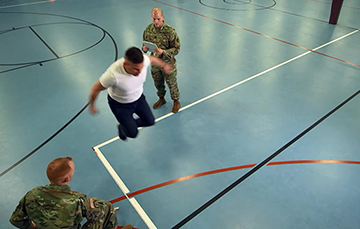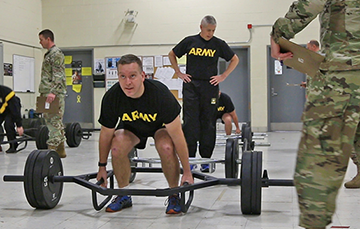Ohio National Guard News
Army implements new physical fitness standards
|
|
Soldiers administer the standing long jump portion of the Occupational Physical Assessment Test to potential recruits during an OPAT pilot program. Beginning in January 2017, the Army began administering the OPAT to all recruits as a way to assess their fitness for military occupational specialties. The OPAT will also be used to assess some Soldiers who are reclassifying into a different MOS. (U.S. Army photo) |
Maj. Brian Eschbach, the 174th Air Defense Artillery Brigade S1 officer, performs the strength deadlift event during a practice Occupational Physical Assessment Test Dec. 22, 2016, at Defense Supply Center Columbus in Columbus, Ohio. Recruiters from Alpha Company, Recruiting and Retention Battalion were getting familiar with grading standards for the new OPAT. (Ohio National Guard photo by 1st Lt. Aaron Smith) |
WASHINGTON, D.C. (01/03/17) — Beginning in January, the Army began administering the Occupational Physical Assessment Test, or OPAT, to all recruits to assess their fitness for military occupational specialties. The OPAT also will be used to assess some Soldiers who are reclassifying into a different MOS. Army Recruiting Command estimates that the OPAT will be administered to about 80,000 recruits and thousands of cadets annually. Soldiers moving into more physically demanding MOSs also will have to meet the OPAT standard, said Jim Bragg, retention and reclassification branch chief for Army Human Resources Command. Under the OPAT, there are four physical demand categories:
When a Soldier wants to reclassify to a new MOS, from the significant category to the heavy category, for example, he or she will need to take the OPAT. However, a Soldier whose new MOS falls within the same or a lower level physical demand category will not need to take the OPAT. The Soldier’s commander will be responsible for ensuring the OPAT is administered prior to approval of a reclassification, Bragg said. As with any reclassification action, the battalion-level or brigade-level career counselor will administer the OPAT. “It is designed to put the right people in the right jobs and to ensure we keep our recruits safe while doing so,” he said. OPAT scoring is “gender neutral,” he added. All Soldiers, male and female, must pass the same physical standards for their desired career field. The test will be administered to everyone coming into the Army: officer, enlisted, active, Reserve and Guard, he said. It will be administered by any command responsible for Soldier accessions — including Recruiting Command and Army Cadet Command — after the Soldier swears in but before he or she begins training. Four Tests of OPATOPAT measures muscular strength, muscular endurance, cardiorespiratory endurance, explosive power and speed. It consists of four individual tests:
Four Physical Demand CategoriesHere is a quick breakdown of the four physical demand categories incorporated into the OPAT:
|
|
EDITOR’S NOTES: ARNEWS reporter Todd Lopez contributed to this report. To view a chart that breaks down the OPAT physical demand categories in correlation to specific military occupational specialties and areas of concentration, click here |
|

